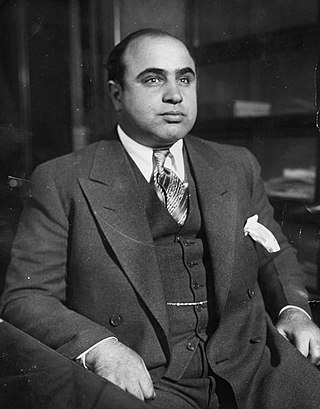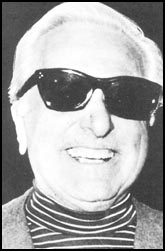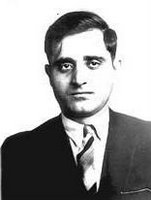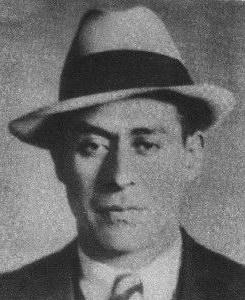Related Research Articles

Alphonse Gabriel Capone, sometimes known by the nickname "Scarface", was an American gangster and businessman who attained notoriety during the Prohibition era as the co-founder and boss of the Chicago Outfit. His seven-year reign as a crime boss ended when he went to prison at the age of 33.

The Saint Valentine's Day Massacre was the murder of seven members and associates of Chicago's North Side Gang that occurred on Saint Valentine's Day 1929. The men were gathered at a Lincoln Park, Chicago garage on the morning of February 14, 1929. They were lined up against a wall and shot by four unknown assailants, two dressed as police officers.

John"Handsome Johnny"Roselli, sometimes spelled Rosselli, was a mobster for the Chicago Outfit who helped that organization exert influence over Hollywood and the Las Vegas Strip. Roselli was recruited by the Central Intelligence Agency (CIA) in a plot to assassinate Cuban leader Fidel Castro.

Jack "Machine Gun Jack" McGurn was a Sicilian-American boxer, mobster, and eventually a made man and caporegime in Al Capone's Chicago Outfit.

Vincent Drucci, also known as "The Schemer", was an American mobster during Chicago's Prohibition era who was a member of the North Side Gang, Al Capone's best known rivals. A friend of Dean O'Banion, Drucci succeeded him by becoming co-leader. He is the only American organized crime boss to have been killed by a policeman.

Kate Barker, better known as Ma Barker, was the mother of several American criminals who ran the Barker–Karpis Gang during the "public enemy era" when the exploits of gangs of criminals in the Midwestern United States gripped the American people and press. She traveled with her sons during their criminal careers.

Frank Ralph Nitto, known as Frank Nitti, was an Italian-American organized crime figure based in Chicago. The first cousin and bodyguard of Al Capone, Nitti was in charge of all money flowing through the operation. Nitti later succeeded Capone as acting boss of the Chicago Outfit.

Paul De Lucia, known as Paul Ricca, was an Italian-American mobster who served as the nominal or de facto leader of the Chicago Outfit for 40 years. In 1958 he was named "the country's most important criminal" by a Senate crime investigating subcommittee. Ricca died on October 11, 1972.
Chicago, Illinois, has a long history of organized crime and was famously home to the American mafia figure Al Capone. This article contains a list of major events related to organized crime.

Roger Touhy was an Irish American mob boss and prohibition-era bootlegger from Chicago, Illinois, in the United States. He is best remembered for having been framed by his rivals in Chicago organized crime for the fake 1933 kidnapping of Jewish-American organized crime figure and Chicago Outfit associate John "Jake the Barber" Factor, a brother of cosmetics manufacturer Max Factor Sr.. Despite numerous appeals and at least one Federal court ruling freeing him, Touhy spent 26 years in prison until he was finally exonerated and released in November 1959. In retaliation for filing a lawsuit against acting boss Tony Accardo and other senior Mafiosi, Touhy murdered in an alleged contract killing by the Chicago Outfit less than a month after his release.
The North Side Gang, also known as the North Side Mob, was an Irish-Polish-American criminal organization within Chicago during the Prohibition era from the early 1920s to the mid-1930s. It was the principal rival of the South Side Gang, also known as the Chicago Outfit, the crime syndicate of Italian-Americans Johnny Torrio and Al Capone.

Louis "Little New York" Campagna was an American gangster and mobster and a high-ranking member of the Chicago Outfit for over three decades.
Salvatore "Frank" Capone was an Italian-American mobster who participated in the attempted takeover of Cicero, Illinois by the Chicago Outfit. He worked in the businesses with his brothers Al Capone and Ralph Capone.

Gus Winkler was an American gangster who headed a Prohibition-era criminal gang specializing in armed robbery and murder for hire with Fred "Killer" Burke. Winkler was a senior associate of Chicago Outfit boss Al Capone and is considered a suspect in the St. Valentine's Day Massacre. Winkler is believed to be the first member of the National Crime Syndicate to be murdered for talking to the FBI.
Fred Samuel Goetz, also known as "Shotgun" George Ziegler, was a Chicago Outfit mobster and a suspected participant in the Saint Valentine's Day Massacre, in 1929.

Franklin Rio also known as "Frank Rio" and "Frank Cline" was a member of Al Capone's Chicago-based criminal organization known as the Chicago Outfit. He was also an alleged gunman in the famous 1929 St. Valentine's Day Massacre.

The Barker–Karpis Gang was one of the longest-lived criminal gangs during the Depression Era, spanning from 1931 to 1935. The gang was founded by Fred Barker and Alvin Karpis, and later joined by Fred's brother Arthur "Doc" Barker. Along with the three core members, the gang's network spanned up to 25 members at one point.

Chicago in the 1930s was one of the major centers of activity in the United States. 1930s Chicago is strongly associated with gangsters and the mafia and speakeasies to provide alcohol following Prohibition. A dark and gloomy time during the Great Depression, many people in the city were unemployed and became dependent on food hand outs in order to get by; many turned to crime as a way to deal with poverty. Many struggling musicians came to the city and found solace in the blues and jazz in the clubs of the city as a way to cope with their grievances. Numerous southern blues and jazz musicians made a name for themselves in the city as they had done in the 1920s. The theater scene in Chicago thrived during this period.

The 1924 Cicero, Illinois, municipal elections were elections held in 1924 to select municipal officers in Cicero, Illinois. The elections were notable for the gang-related violence which took place.
References
- 1 2 3 4 5 6 7 8 9 Sifakis, Carl (2005). The Mafia Encyclopedia. Infobase Publishing. pp. 244–245. ISBN 9780816056941.
- 1 2 3 4 5 6 Newton, Michael (2002). The encyclopedia of Kidnappings. Infobase Publishing. pp. 65–67. ISBN 0-8160-4486-4.
- 1 2 3 4 5 6 7 8 9 10 11 Walters, Christine. ""Handsome Jack" Klutas". Genealogy Trails. Retrieved 1 November 2011.
- ↑ Sherriff W. Sweet and Marshal Aaron Bailey